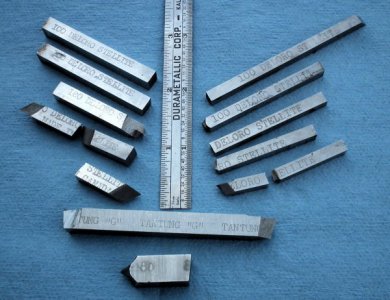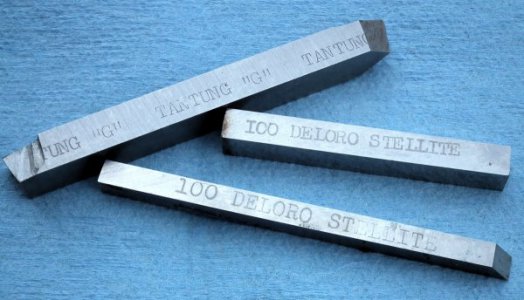- Joined
- Oct 10, 2018
- Messages
- 543
I figured out that I have several lathe tool blanks of Stellite. With my tiny 6X18 Atlas lathe, I'm wondering where best to use them?
In a box lot from a recent auction purchase, there were quite a few tool blanks. At first I thought they were all HSS but when I looked up the name "Deloro Stellite", I found that it is not a steel at all. It has no iron content and is not attracted to a magnet. Apparently these super alloys were developed about the same time as carbide tooling. They can be run far hotter than HSS without losing hardness--up to a red heat!. Carbide can run hotter still. However, Stellite handles shock better than carbides and is therefore better for intermittent cuts that would chip or crack carbide. Stellite can be ground with standard aluminum oxide wheels so no special requirements for sharpening. However, they should not be quenched in water--thermal shock is apparently bad. Wear a mask, the dust is toxic.

All the pieces on the upper left are 1/4" square, 3/16" on the right. The short piece at the bottom is 3/8" and the Tantung G blank is 5/16".

I'm not clear if Stellite holds a sharp edge longer than HSS.
For my shop, I'm not sure what would be the best use. I think using it in a fly-cutter type tool would make sense. It would allow pretty aggressive metal removal at relatively high fpm.
Other than that, I'm struggling. A lathe roughing tool of Stellite might work for others by my little Atlas doesn't have the rigidity or power to hog off deep cuts.
If it does maintain a sharp edge better than HSS, I could see it for threading tools or in place of HSS cutters in boring tools.
BTW, if you like more background on such tool blanks, there is a a good web page at:
From what I read, Stellite tools can be run at cutting speeds roughly twice that of HSS and nearly as fast as carbide. The Blackalloy Company also has some detailed recommendations on tool geometry and cutting speeds at:

 www.blackalloy.com
www.blackalloy.com

 www.blackalloy.com
www.blackalloy.com
Note that new Stellite tool blanks are roughly 10X the cost of HSS!
Craig
In a box lot from a recent auction purchase, there were quite a few tool blanks. At first I thought they were all HSS but when I looked up the name "Deloro Stellite", I found that it is not a steel at all. It has no iron content and is not attracted to a magnet. Apparently these super alloys were developed about the same time as carbide tooling. They can be run far hotter than HSS without losing hardness--up to a red heat!. Carbide can run hotter still. However, Stellite handles shock better than carbides and is therefore better for intermittent cuts that would chip or crack carbide. Stellite can be ground with standard aluminum oxide wheels so no special requirements for sharpening. However, they should not be quenched in water--thermal shock is apparently bad. Wear a mask, the dust is toxic.

All the pieces on the upper left are 1/4" square, 3/16" on the right. The short piece at the bottom is 3/8" and the Tantung G blank is 5/16".

I'm not clear if Stellite holds a sharp edge longer than HSS.
For my shop, I'm not sure what would be the best use. I think using it in a fly-cutter type tool would make sense. It would allow pretty aggressive metal removal at relatively high fpm.
Other than that, I'm struggling. A lathe roughing tool of Stellite might work for others by my little Atlas doesn't have the rigidity or power to hog off deep cuts.
If it does maintain a sharp edge better than HSS, I could see it for threading tools or in place of HSS cutters in boring tools.
BTW, if you like more background on such tool blanks, there is a a good web page at:
From what I read, Stellite tools can be run at cutting speeds roughly twice that of HSS and nearly as fast as carbide. The Blackalloy Company also has some detailed recommendations on tool geometry and cutting speeds at:

Blackalloy Multi Spindle Drill Heads, Tapping, And More
Blackalloy Multi Spindle Drill Heads, Self-Feeding Drill Units. Industrial Automatic Drilling and Tapping Units. Cutting Tools, Drill Unit Components and more.

Blackalloy Multi Spindle Drill Heads, Tapping, And More
Blackalloy Multi Spindle Drill Heads, Self-Feeding Drill Units. Industrial Automatic Drilling and Tapping Units. Cutting Tools, Drill Unit Components and more.
Note that new Stellite tool blanks are roughly 10X the cost of HSS!
Craig


